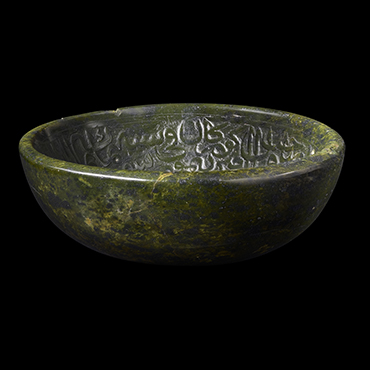Drinking bowl of the ‘Wonder of the Age’
Inscribed:
Oh Allah, open the gates of prosperous rule and blessings and future victories every day before the face of the commander, Lord of the Conjunction, Amir Timur Gurkan, in the months of the year eight hundred.
This bowl, inscribed with the name of one of the greatest leaders in Islamic history, is of exceptional importance not only as a royal vessel but also as the earliest securely dated carved jade from anywhere in the Islamic world. The Turco-Mongol peoples considered jade as a “victory stone” since at least the 5th/11th century. Jade’s continued associations with power and prestige may have influenced its selection for this royal bowl, emulating the Timurids’ Mongol predecessors.
The dynasty’s founder, Timur (r. AH 771–807/1370–1405 CE), was known to appreciate jade and ordered three large blocks of the green stone, though only one arrived during his lifetime. The dark green stone of this bowl closely resembles that of other early Timurid jades, including Timur’s tombstone, crafted from a huge block of jade brought to the Timurid capital of Samarkand by his grandson Ulugh Beg (r. AH 850–52/1447–49 CE).The inscription on this bowl calls on Allah for prosperity and impending victory. The date in the inscription aligns with Timur’s preparations for his invasion of India, which culminated in the capture and looting of Delhi in AH 801/1398 CE. Timur is referred to as Gurkan, derived from the Mongol word kuragan (son-in-law), highlighting his familial connections to Genghis Khan. Throughout the central Islamic world, bowls of this shape, more commonly made of metal, were often inscribed with texts believed to offer protection. This exquisite bowl may have been used to invoke protection for Timur as he prepared to embark on his campaign.
Drinking bowl of the ‘Wonder of the Age’
Bowl
Bearing the name and titles of Timur
Iran or Central Asia, 800 AH/1397–8 CE
Jade, diam. 12 cm
Furusiyya Art Foundation, R-4002

